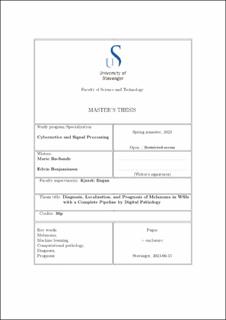| dc.contributor.advisor | Engan, Kjersti | |
| dc.contributor.author | Benjaminsen, Edvin | |
| dc.contributor.author | Bø-Sande, Marie | |
| dc.date.accessioned | 2023-08-25T15:51:19Z | |
| dc.date.available | 2023-08-25T15:51:19Z | |
| dc.date.issued | 2023 | |
| dc.identifier | no.uis:inspera:129730556:34429505 | |
| dc.identifier.uri | https://hdl.handle.net/11250/3085854 | |
| dc.description.abstract | The most dangerous and aggressive form of skin cancer is melanoma, responsible for 90% of skin cancer mortality. Early detection of melanoma plays a crucial role in the prognostic outcome. The diagnostic has to be performed by a pathologist, which is time- consuming. The recent increase in melanoma incidents indicates the growing demand for a more efficient diagnostic process.
This thesis’s main objective is to develop a pipeline utilizing two independent pre- trained models built on the VGG16 architecture. This pipeline consists of a diagnostic and a prognostic model. The diagnosis model is responsible for localizing malignant patches in WSIs and giving a patient-level diagnosis. The prognosis model uses the output from the diagnosis model to provide a patient-level prognosis. The complete pipeline provides both a prognostic and a diagnostic tool, which can be used by a pathologist when evaluating Whole Slide Images (WSIs). A total of 243 WSIs were provided by Stavanger University Hospital for this thesis. All have been provided a patient-level label. 203 of the WSIs were used for parameter tuning and 40 were used for testing.
The diagnosis model performed with a 100% accuracy when evaluated on the original test, which was provided together with the training set. The prognosis model also per- formed well on the original dataset, with an accuracy of 0.7885. The model’s capability to predict diagnosis and prognosis decreases significantly when being introduced to the new dataset. In addition to developing the pipeline, some parameters for the diagnosis model was found using a ROC cuve. By using the new parameters for the diagnosis model on the validation set, the performance of the diagnosis model increased when using the test set. The prognosis model performed relatively equally in all experiments. A correlation between the number of patches in a WSI and the number of patches predicted malignant was discovered and counteracted by altering the patient-level threshold calculation method. | |
| dc.description.abstract | The most dangerous and aggressive form of skin cancer is melanoma, responsible for 90% of skin cancer mortality. Early detection of melanoma plays a crucial role in the prognostic outcome. The diagnostic has to be performed by a pathologist, which is time- consuming. The recent increase in melanoma incidents indicates the growing demand for a more efficient diagnostic process.
This thesis’s main objective is to develop a pipeline utilizing two independent pre- trained models built on the VGG16 architecture. This pipeline consists of a diagnostic and a prognostic model. The diagnosis model is responsible for localizing malignant patches in WSIs and giving a patient-level diagnosis. The prognosis model uses the output from the diagnosis model to provide a patient-level prognosis. The complete pipeline provides both a prognostic and a diagnostic tool, which can be used by a pathologist when evaluating Whole Slide Images (WSIs). A total of 243 WSIs were provided by Stavanger University Hospital for this thesis. All have been provided a patient-level label. 203 of the WSIs were used for parameter tuning and 40 were used for testing.
The diagnosis model performed with a 100% accuracy when evaluated on the original test, which was provided together with the training set. The prognosis model also per- formed well on the original dataset, with an accuracy of 0.7885. The model’s capability to predict diagnosis and prognosis decreases significantly when being introduced to the new dataset. In addition to developing the pipeline, some parameters for the diagnosis model was found using a ROC cuve. By using the new parameters for the diagnosis model on the validation set, the performance of the diagnosis model increased when using the test set. The prognosis model performed relatively equally in all experiments. A correlation between the number of patches in a WSI and the number of patches predicted malignant was discovered and counteracted by altering the patient-level threshold calculation method. | |
| dc.language | eng | |
| dc.publisher | uis | |
| dc.title | Diagnosis, Localization, and Prognosis of Melanoma in WSIs with a Complete Pipeline by Digital Pathology | |
| dc.type | Master thesis | |
